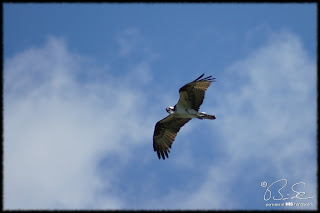Well, vacation is over for the summer, back from my second time up at the Lodge in Bancroft. Although shorter for me, we had a great time with Holly's side of the family. It was cooler than the record highs of our previous stint in Bancroft, which meant a little less water activities. But a great time with relaxing and even construction of a new swing over the water.
Still sharing pictures with you from my week with my family in July... I got to see and get some pictures of what really are my favourite group of wildlife, raptors. They are hard to photograph, having such great eye sight, and having a preference to be left alone for the most part.
When we arrived that week, I quickly noticed characteristic, piercing cries of a raptor. Soon I located the source, across the lake three falcon-like figures, rolling and diving, chasing and then fleeing from each other with great speed. A couple years back I remembered having gotten quite close to a young falcon/hawk (didn't get close enough to see which), and recognized the cry as being similar.
Not wanting to be accused of disappearing right away from family vacation time, I put it off for a number of days into the holiday. On one of our last days, I noticed I had not heard the sound of the birds, which is a persistent "kee, kee, kee", somewhat reminiscent of a killdeer. I was afraid I had waited to long. One of my brothers, Dan and I thought we'd see if we could find what we guessed would be a nest site in the large pine which they seemed to frequent most of the time. After about an hour of hiking in the bush on that side of the lake, and not finding the nest, patience finally paid off, not because of a skillful search, but with the tell-tale cries coming nearer and nearer. We came down from the ridge we were on, and walking on, Dan spotted the first, then the second juvenile Merlin, quite grown up already. The one didn't hang around long, but the other decided to take a nap there. I had to stop short of banging pots and pans to get it to open its eyes for some photographs - well, not quite. You can see it sleeping in the third of the photo-strip picture below.
 |
| Juvenile Merlin |
 |
| Spreading, Scratching, Snoozing, Stretching Juvenile Merlin |
On the way back to the Lodge, my brother spotted the nest, in one of the big pines on the lot of one of the cottages across the lake from us. It was much closer to the water than I had thought. Recent talk in Holly's family might mean that we'll be back next year in July, which might mean another attempt to get a little closer to the young. I'd love to try and get into one of the nearby trees to get a nest view, but don't think that will be possible.
 |
| Merlin Nest |
I posted some facts about Merlin when I saw my first one in Myrtle Beach this past winter.
 |
| Osprey nest with Adult and Juvenile |
As we approached, the adult on the left sounded a warning, and the juvenile (though already as large as the adult) quickly disappeared out of site in the nest. The parent took off and warily circled, higher, then lower, around us as we walked nearer to the nest.
 |
| Osprey circling as we approached the nest |
Osprey are large raptors, with wing spans of up to 6ft that feed almost exclusively on fish. They will watch with amazing eyesight, for a fish in a lake, stream, or river, and then dive, often from great heights, and pull up, feet first to grip their prey, sometimes fully submerging themselves under the water to reach their quarry. They have unique feet compared to other hawks, with one toe being able to pivot backwards or forwards to assist the other rear toe, extending long, sharp talons into slippery, scaly fish. As they climb up from the water's surface, sometimes with a fish weighing as much as they do, they will arrange the catch to be head first, a more aerodynamic position reducing the effort required gain altitude again and head back to the nest.
The osprey was also designed with special legs compared to most raptors; they are much more heavily muscled, longer to reach deep into the water (up to 3 feet) and covered with very thick feathers to help cushion the impact as they hit the water during the speedy dives to surprise and catch the fish.
An interesting link with more information (and some of the information above) can be found here:
If time had allowed the adult might have gotten more trusting and landed on the nest to allow for closer shots. However, after the 5 minutes (likely 10) we walked back, turning around to get some pictures of it landing to assure junior again.
 |
| Osprey landing at the nest. |


No comments:
Post a Comment
Sorry about the annoying word verification... I've been deluged with Spam comments lately and some have been offensive.